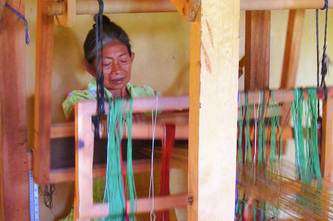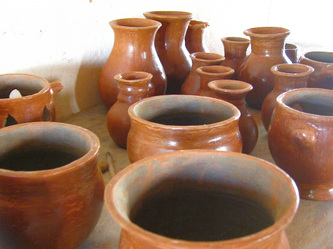Artisans & Crafts
CONIMCHH is the umbrella organization for over 100 indigenous Ch’ortí Maya aldeas (villages) around the Copan Ruinas region in Honduras, Central America.
Many individuals in these communities are skilled artisans and hand-make crafts for both practical/ceremonial functions and tourism. It is the eventual goal of this website to represent all artisans within the CONIMCHH community.
Many individuals in these communities are skilled artisans and hand-make crafts for both practical/ceremonial functions and tourism. It is the eventual goal of this website to represent all artisans within the CONIMCHH community.

Maize Dolls of La Pintada
Maize (corn) holds both religious and practical aspects in Ch’ortí Maya society. From the religious perspective maize is important because it was the material in which the gods created humanity (after first trying mud and wood). Practically, maize grows well in the region’s environment and its byproducts can be used for fuel and other functions.
As a representation of maize's importance and to supplement income, several Ch’ortí women in the aldea of La Pintada hand craft dolls and other ornaments using corn husks, color dyes, water, wire and glue. Each doll typically requires an hour to produce and the artisans have begun making other designs, including crèches and flowers.
Maize (corn) holds both religious and practical aspects in Ch’ortí Maya society. From the religious perspective maize is important because it was the material in which the gods created humanity (after first trying mud and wood). Practically, maize grows well in the region’s environment and its byproducts can be used for fuel and other functions.
As a representation of maize's importance and to supplement income, several Ch’ortí women in the aldea of La Pintada hand craft dolls and other ornaments using corn husks, color dyes, water, wire and glue. Each doll typically requires an hour to produce and the artisans have begun making other designs, including crèches and flowers.

Weavings of La Pintada
With initial assistance and training from a Japanese development organization, a small group of Ch’ortí Maya began making textiles in 2005 using manual looms with materials bought in the local pueblo of Copan Ruinas.
Currently the workshop has several looms where scarves, blankets, throw cloths, and other goods are hand-made. The education required to master this skill typically takes around three months and funds generated through the organization help pay for supplies, education, and sustenance for families in the village.
With initial assistance and training from a Japanese development organization, a small group of Ch’ortí Maya began making textiles in 2005 using manual looms with materials bought in the local pueblo of Copan Ruinas.
Currently the workshop has several looms where scarves, blankets, throw cloths, and other goods are hand-made. The education required to master this skill typically takes around three months and funds generated through the organization help pay for supplies, education, and sustenance for families in the village.

Pottery of Carrizalón
Carrizalón, one of the larger aldeas within CONIMCHH and one of the first to benefit from land reforms, is home to a small pottery cooperative comprised of several Ch’ortí Mayan women.
At first, the group made large pottery used for ceremonial purposes as well as to make large quantities of tortillas, chicha (corn beer), and beans for community-wide feasts. Most recently, the artisans have begun to apply their creative talents to make more ornate and decorative designs and jewelry to attract tourists and help fund community projects and purchase goods and supplies.
Carrizalón, one of the larger aldeas within CONIMCHH and one of the first to benefit from land reforms, is home to a small pottery cooperative comprised of several Ch’ortí Mayan women.
At first, the group made large pottery used for ceremonial purposes as well as to make large quantities of tortillas, chicha (corn beer), and beans for community-wide feasts. Most recently, the artisans have begun to apply their creative talents to make more ornate and decorative designs and jewelry to attract tourists and help fund community projects and purchase goods and supplies.









